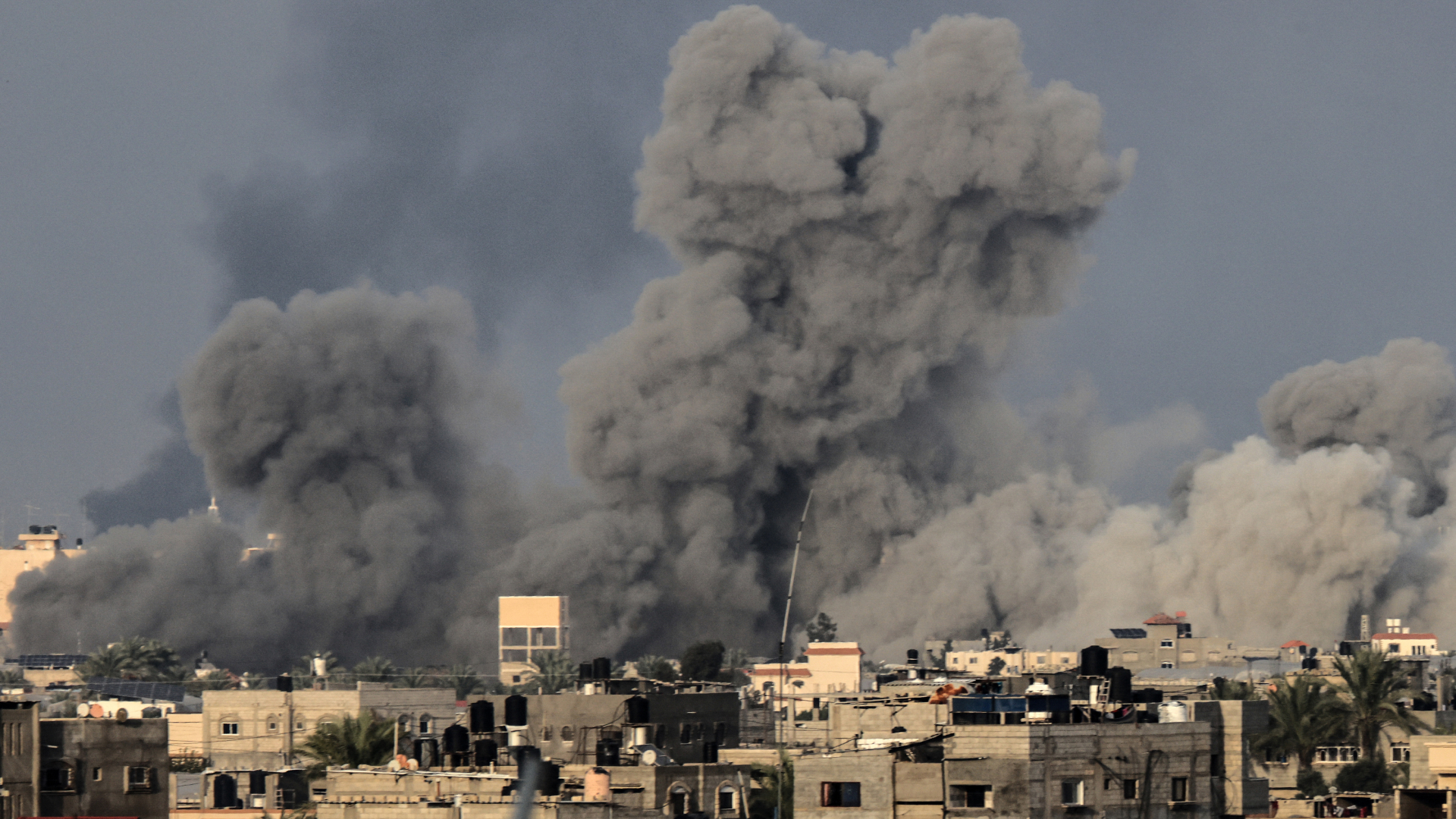After a Rafah ground operation, Israeli security forces are likely to remain in Gaza to fight against remnants of Hamas and Palestinian militancy in Gaza for the rest of this year.
This assessment was issued to clients of Dragonfly’s Security Intelligence & Analysis Service (SIAS) on 27 March 2024.
- A recent intensification in exchange of fire suggests the risk of a full-blown war between Israel and Hezbollah remains high – but not imminent – in our assessment
- A peace deal and a complete end of hostilities in Gaza seem both very unlikely this year
With a ground offensive on Rafah looming, clients have asked us what the trajectory of the war in Gaza will be for the rest of the year. International support for Israel is also diminishing – as the recent approval of a UN Security Council of a ceasefire demonstrates – and the current government looks weak. Because of this, Israel will probably wind down its military operations in Gaza to fight remnants of Hamas militancy by the end of the year. Still, Israeli security forces still seem to be keen on degrading Hezbollah’s capabilities in southern Lebanon. So the risk of a major military conflict with the group remains high but not imminent.
Israel highly likely to focus on defeating Hamas
Defeating Hamas is highly likely to remain the main goal for Israel this year. This is what Israeli officials have been repeating since the start of the war in October. The Israeli prime minister, Benjamin Netanyahu, has recently said that ‘total victory against Hamas’ is the priority of his government. That has not been achieved yet. Local media reports as well as international think tanks recently noted that at least three Hamas battalions remain active in Rafah, while others have been severely damaged.
To achieve its objective, the Israeli security forces will have to first defeat all of Hamas’ remaining battalions in Rafah. We anticipate they will try to do so in the period from April to June. Based on our understanding of recent Israeli actions in Gaza, it would take around three months for the Israeli forces to seize Rafah. They would have to evacuate Palestinians displaced there first, intensify an aerial bombing campaign and then begin a ground operation.
From July (presuming the above timeline holds) until the end of the year, some Israeli security forces would remain in Gaza. This is mainly because we doubt that Israel will be able to completely eradicate Hamas militancy from Gaza. There are also two other reasons. First, there is no plan for governance in Gaza after the war; the Israeli authorities issued a post-war plan in mid-February with no clear mention of who will be in charge of security there. Second is support for Hamas or any armed resistance against Israel is well rooted among many Palestinians; we anticipate that it will be relatively easy for Hamas or any offshoots to recruit new militants.
Government stability and international support to affect conflict
We have identified two key determinants for the trajectory of the war: the stability of the current Israeli government and international support for Israel. Both have the potential to significantly affect the course of the military operations in Gaza. This is mainly because the current government, in particular the war cabinet, approves all military plans in Gaza while international allies, mainly the US, provide political and military support to Israel.
It is possible if not probable that the current Israeli government will collapse over the next six months. This is due to emerging disagreements among its government’s members over the handling of the war, particularly the hostage situation and post-war Gaza. Benny Gantz, an important member of the war cabinet, reportedly met with US officials earlier this month in what the Israeli press described as an ‘unauthorised’ trip. Should the cabinet collapse there would be new parliamentary elections by the end of the year, based on how this has previously played out.
International political support for Israel is also likely to diminish in the coming months. There have been recent official statements by important allies of Israel, including the US, showing disagreements with the conduct of operations in Gaza and the need to allow more humanitarian aid there. And the US recently tabled a resolution on a ceasefire to the UN Security Council, which passed on 25 March. All past resolutions were previously vetoed by the US. The Israeli authorities seem to have brushed off most of these calls by allies and they still seem to have military support from the US.
Scenarios for 2024
Based on these key factors and estimates, we have outlined three scenarios to support planning for the rest of the year. These revolve around several plausible trajectories of the conflict and their implications for Gaza, Israel and the region.
 Scenario A: Israel fights a Hamas-led insurgency in Gaza
Scenario A: Israel fights a Hamas-led insurgency in Gaza
A low-intensity conflict continues between Israel and remnants of Hamas militants in Gaza
50% most probable scenario
Disagreements within the war cabinet on how to handle the post-Gaza operation environment and declining international political support for Israel lead the Israeli government to collapse. This prompts the Israeli authorities to hold elections, amid a temporary truce between Israel and Hamas for humanitarian reasons. A new government is formed, the main focus of which is the release of the remaining hostages and a ceasefire agreement with Hezbollah. Israel withdraws heavy weaponry from Gaza but retains control of the strip; it moves its focus to suppressing remnants of Hamas and Palestinian militants in the territory.
This scenario will have the following implications:
- A conflict between Israel and Palestinian militant groups continues with Israeli security forces mounting almost daily raids into Gaza and the rest of the West Bank to defeat remnants of Palestinian militancy
- Pro-Iran groups in the region (Syria, Iraq, Yemen) reduce the frequency of their attacks on Israel and the US from weekly to monthly
- Hezbollah and Israel engage in weekly rather than daily exchanges of fire
- Displaced Israeli communities in the north return home
- The terrorism threat remains between high and severe in Israel
The indicators that would suggest this scenario is becoming less likely:
- Israel steps up aerial bombing campaign into Lebanon killing Hezbollah senior leaders and targeting civilian infrastructure countrywide
- Palestinian militant groups mount a large campaign of attacks in Israel as well as in the Israeli settlements of the West Bank
- The US announces it will increase the pace of military aid delivery to Israel from monthly to weekly
- New Israeli elections result in a far-right government that decides to annex Gaza, expel Palestinians and launch an attack on Lebanon
- West Bank militants mount mass casualty terrorist attacks against settlements
Scenario B – Full Israeli occupation of Gaza and intensified operations in Lebanon
Israel fully occupies Gaza and ramps up military operations against Hezbollah in Lebanon
35% second most probable scenario
Amid waning international support for Israel’s military operations in Gaza and in the region, the current far-right government doubles down on its aspirations to completely defeat Hamas and armed groups in the region. This includes a full occupation of Gaza and a step up of military operations against Hezbollah. Israel maintains its objective of a complete destruction of Hamas, and that no political structure for Gaza will be implemented until it achieves this.
This scenario will have the following implications:
- The conflict expands to southern Lebanon with Israel intensifying it’s aerial bombing campaign to drive Hezbollah north of the Litani river
- A severe humanitarian crisis continues in Gaza as Israel creates obstacles to the entry of humanitarian aid
- Armed groups in Syria, Iraq and Yemen mount attacks against Israel most days
- There are weekly pro-Palestine protests
- Governance breaks down in Gaza with no authority capable of delivering basic services
- Daily anti-government protests of several hundreds in Israel
Indicators that this scenario is becoming more likely are:
- The Israeli authorities issue an ultimatum to start a sustained military campaign against Hezbollah unless the group starts to disarm of all its forces south of the Litani river
- The Israeli authorities cut diplomatic ties with several countries, including allies, over disagreements related to the conduct of the war in Gaza
- The Israeli military recalls reservists
- The Israeli military builds a permanent structure of checkpoints and observation towers in Gaza
- New Israeli elections result in a far-right government that calls for Israel to annex Gaza, expel Palestinians and launch an attack on Lebanon
Scenario C: Conflict ends
The conflict ends and a peace process between Israelis and Palestinians restarts
15% least likely scenario
Disagreements within the war cabinet over how to handle the post-major military operations in Gaza and the hostage situation leads the government to collapse. A new more moderate Israeli government is elected and there is resurgent international support for Israel. Hamas, weakened by months-long war, decides to open up to international efforts to resume a peace process, which the Israeli government is also amenable to. Such a scenario remains very unlikely as on current indications there is no political will on both sides to end the conflict and start a negotiation process.
This scenario will have the following implications:
- A full-fledged regional war is unlikely
- The Israeli army hands over security to a Palestinian governing authority
- Humanitarian crisis in Gaza eases
- An international-led peacekeeping mission is established in Gaza
- Frequency of pro-Palestine protests regionally and globally decline from weekly to at least monthly
Indicators that this scenario is becoming more likely are:
- Opinion polls suggest that a large coalition of centre-left parties with a political program calling for the end of the conflict and restart of the peace process will win parliamentary elections in Israel
- The Israeli security forces begin the withdrawal of their troops from Gaza and dismantle the structure of permanent checkpoints and observation towers
- Hezbollah announces it will stop attacks from the north
- The Israeli authorities announce that communities in the north can return home
- Hamas announces the end of the military operations against Israel
Image: Smoke billowing above buildings during Israeli bombardment on Khan Yunis in the southern Gaza Strip, Palestine, on 7 December 2023. Photo by Mahmud Hams/AFP via Getty Images.




